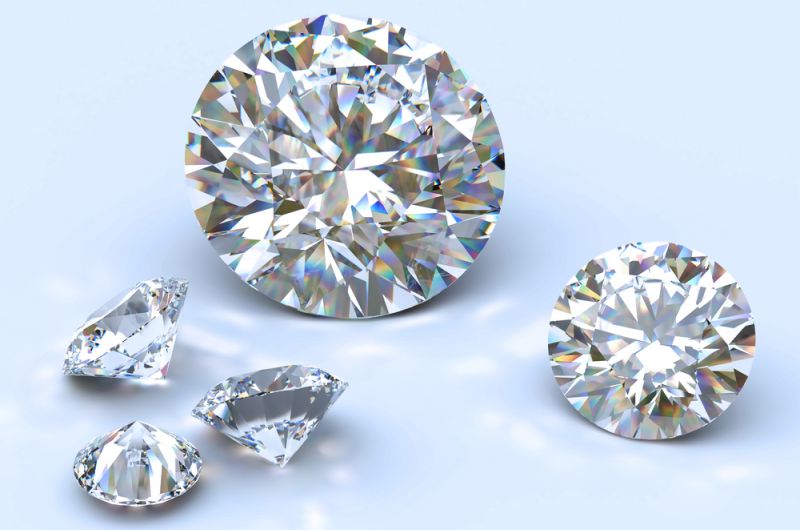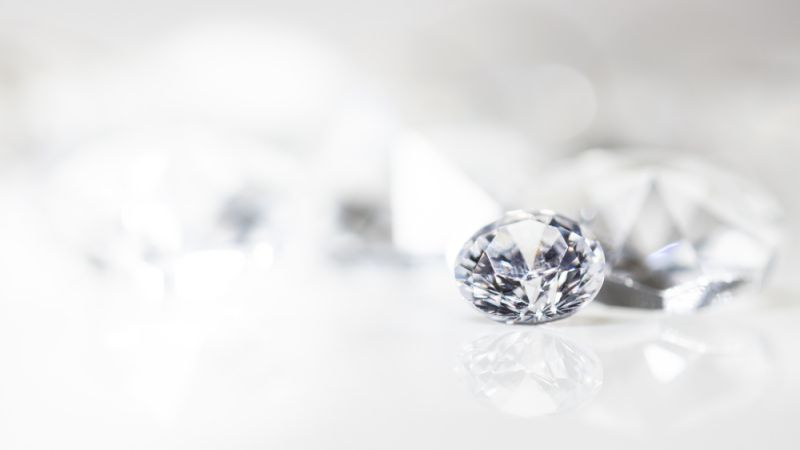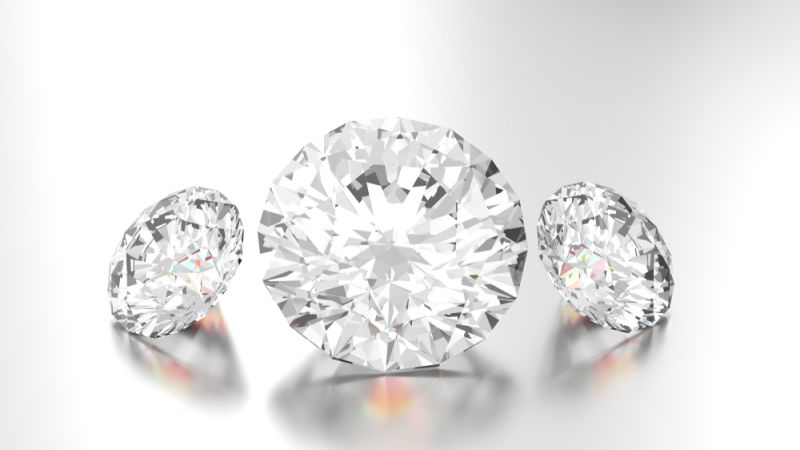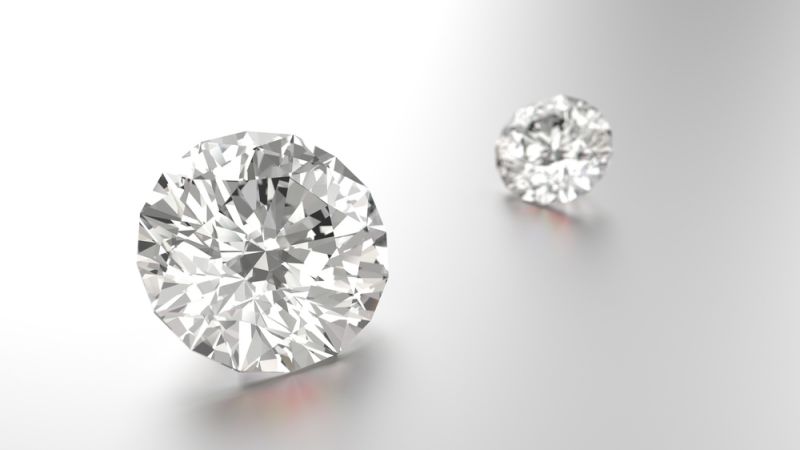Diamonds can be complex to evaluate, especially for first-time buyers. Many of their characteristics are invisible to the naked eye or difficult to assess and classify accurately.
One noticeable defect in diamonds is the diamond bow-tie effect, which can be easily seen. This defect creates a shadow resembling a bow tie in the middle portion of the gemstone. It occurs due to poor cutting, which restricts the reflection of light in the center of the diamond.
In this article, we will provide you with comprehensive information about the diamond bow-tie effect, including what to look for and details about the diamond’s cut. By understanding these aspects, you will be better equipped to evaluate a diamond’s characteristics before making a purchase.
DESIGN YOUR OWN ENGAGEMENT RING: START WITH A SETTING OR START WITH A DIAMOND. IT’S REALLY UP TO YOU!

What Is The Bow-Tie Effect?
The bow tie effect in diamonds is exactly what it sounds like—a bow tie-shaped black stripe that appears on the diamond’s surface. When viewed from a specific angle, this black stripe becomes noticeable and diminishes the stone’s beauty.
There are some common misconceptions about the bow tie effect, such as attributing it to trapped substances within the diamond or specific inclusion patterns. It is also unrelated to light leakage through the diamond’s sides, which is a separate issue commonly found in diamonds.
In reality, the bow tie effect is primarily caused by a poor cut. Diamonds with bow ties have a section in the middle where light is not adequately reflected due to the inferior cut quality. This effect is typically visible from specific angles, often when the viewer’s shadow is reflected within the stone. Essentially, the bow tie represents a shadow within the diamond, making that area appear darker.
Ideally, diamonds are cut to maximize light reflection and should not have such shadows. However, when the diamond’s cut is imperfect, it can result in the presence of a bow tie effect.

Which Diamond Shapes Have Bow-Tie Effect?
The bow tie effect is commonly observed in elongated fancy diamond cuts, such as marquise, pear, and oval shapes. Some square shapes, like the radiant cut, can also display bow ties. On the other hand, diamond shapes like round brilliant, cushion, princess, and emerald do not typically exhibit bow ties.
The challenge of avoiding bow ties is particularly prominent when cutting elongated stone shapes. The middle area of these shapes is elongated, making it difficult to cut the facets in a way that properly reflects light.
However, it’s important to note that not all elongated diamond shapes necessarily have bow ties. While it may seem simple to expect diamond cutters to avoid creating bow ties in their stones, diamond cutting is a complex craft, and even the most skilled cutters can make mistakes.
Several factors can contribute to the presence of a bow tie in a diamond:
- Mistakes: The diamond cutter may have made errors during the cutting process, resulting in misaligned facets and the formation of a bow tie.
- Rough preservation: Sometimes, to retain as much of the rough diamond’s weight as possible, cutters may be compelled to cut the stone in a way that minimizes excessive loss of carat weight.
In the diamond industry, profit is a significant consideration, and larger diamonds are often preferred. While every diamond cutter aims to create the most visually appealing diamonds, practical factors and constraints may influence their decisions.
- Inclusion avoidance: In certain cases, the diamond cutter may have had to make specific cutting choices to avoid exposing or enhancing inclusions within the diamond. Bow ties, although unattractive when pronounced, may be deemed the lesser of two potential flaws in such situations.
Overall, the presence of a bow tie in a diamond can be influenced by various factors, and achieving a perfect balance between maximizing beauty and addressing practical considerations is a complex task for diamond cutters.

Is Bow Tie Effect Always A Bad Thing?
The bow tie effect is commonly observed in oval, pear, and marquise-shaped diamonds, although the severity of the effect varies. Most bow ties are subtle and not highly noticeable.
Interestingly, certain bow ties can even be considered a positive attribute. If the bow tie is not too prominent and the diamond is well-shaped around it, it can enhance the stone’s sparkle and scintillation.
However, it’s important to be cautious of dishonest diamond vendors who may try to portray the bow tie effect as universally positive. While it is true that the lighter bow tie effect can have a favorable impact on a diamond’s appearance, overall, it is still considered a negative factor. If possible, it is advisable to avoid diamonds with a pronounced bow tie effect.
Here are a few things to keep in mind when evaluating diamonds:
- Lighting and angles: It can be challenging to spot the bow tie effect in physical jewelry stores due to the lighting conditions. Therefore, it is recommended to examine the stone from various angles and under different light sources, including daylight.
- Online purchases: If buying a diamond online, ensure that you have access to a 360-degree video of the stone and the ability to magnify its images. Reputable online vendors, such as James Allen, often provide detailed videos and images for customers to make informed decisions.
- Purchase from reputable vendors: Whether buying online or in a physical store, always choose reputable vendors known for their quality and transparency.
- Return policies: Check the return policies of the store to ensure that you have the option to return or exchange the diamond if any issues arise, such as the bow tie effect.
The Importance of Diamond Cut:
The diamond’s cut plays a crucial role in its beauty and overall appearance. It refers to how well the stone is cut, polished, and proportioned, rather than its shape (e.g., pear or oval). A well-cut diamond exhibits luminosity and reflects light back to the viewer’s eyes, resulting in brilliance. In contrast, a poorly cut diamond appears dull and lacks sparkle.
The diamond cut grade is determined by factors such as polish, symmetry, brilliance, and fire. The Gemological Institute of America (GIA) provides a commonly used grading system, ranging from Poor to Excellent. Diamonds with an Excellent cut grade display the highest level of fire and brilliance, while Poor cut diamonds lack sparkle and brilliance.
Various elements impact a diamond’s cut, including proportions, facets, light reflection, symmetry, and finishing details. Cut quality is the most critical factor in a diamond’s value and significantly affects its aesthetic appeal.
Price variations exist based on the cut grade. Diamonds with precise proportions and symmetry command higher prices because they refract and reflect light more effectively, resulting in superior brilliance. Investing in a well-cut diamond is worthwhile, as it enhances the stone’s overall beauty and appearance, surpassing the importance of clarity or color.
Distinguishing Diamond Cut from Diamond Shape:
It is essential to differentiate between diamond cut and diamond shape, as these terms have distinct meanings. Diamond shape refers to the outline or figure of the gemstone, such as round brilliant or pear-shaped. On the other hand, diamond cut refers to the stone’s facets, dimensions, symmetry, and reflective qualities.
A heart-shaped diamond, for instance, can have different qualities of cut, such as being too deep, shallow, dull, or brilliant, while still retaining the heart shape. The quality of the cut greatly influences a stone’s fire and brilliance, emphasizing the importance of a well-cut diamond.

Wrapping Up
To ensure you make a wise purchase when selecting a diamond shape that may be susceptible to the bow-tie effect, it is essential to thoroughly inspect the diamond and have access to high-quality imagery of the gemstone. These measures will enable you to make an informed decision regarding the diamond’s physical and aesthetic characteristics.
To facilitate this process, we recommend exploring reputable online jewelry stores that utilize advanced diamond display technology.
While the bow tie effect may not be a significant concern in most cases, if it immediately catches your attention and detracts from the overall beauty of the diamond, it is advisable to seek an alternative stone. While a diamond may possess a bow tie, if it becomes the focal point rather than enhancing the stone’s allure, it defeats the purpose of owning a diamond.
Keep in mind that the cut quality of the diamond is the most crucial factor to consider when making a purchase. Ensure that your chosen stone has an excellent diamond cut grade, as it significantly contributes to the diamond’s beauty and value.


